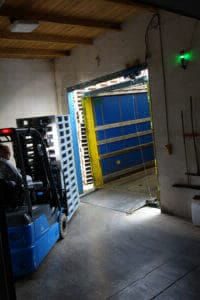Nevertheless, some bugs remained in the system. While the transponders of the pallets were reliable and fast read by the Nordic ID AR55, one needed to ensure that non-moving transponders are filtered out. Reflections caused by forklift trucks also required additional tinkering in reader settings and middleware algorithms, explains Walter Seibel from Sydesoft.
– To avoid reflections or reading of non-moving tags, WS-RFIDGate provides special algorithm and configuration to customer needs. WS-RFIDGate uses different beam-collections to detect moving tags that were in the hotspot area. Other tags, which are not in the hotspot reading area, will be ignored, says Seibel.
WS-RFIDGate also uses the movement-detection of Nordic ID AR55 firmware. In the end, the winning combination of movement-detection of Nordic ID AR55 firmware and beam-collection filtering solved the lingering problems of reflection and other unwanted reads.
– Working together with Nordic ID’s experts in Finland, we were able to eliminate the remaining problems in a couple of weeks, Seibel looks back.
SAVING TIME
Now, the solution enables Zentek’s warehouse to load and unload pallets in stacks while transponders are read simultanously − there’s no need to prepare and capture pallet IDs in advance and/or use time-consuming barcode scanning.
– No costly or bulky RFID hardware was needed at all. WS-RFIDGate generates standardized EPCIS events and addresses to capture web service of the EPCIS, thus providing realtime data for the Zentek’s IT system, comments Freda who was the project leader in the RFID venture.
– The time savings that we are able to achieve are approximately one hour per truckload on warehouse staff and forklift truck. Also, approximately 50 square metres of the staging area is saved for other use, he adds.
Furthermore, shipping and receiving processes are now being covered by one technical solution. Future roll-out to other warehouse processes and locations may be in the cards as well, since roll-out can now be achieved via configuration − there’s no need for individual programming and hardware installation at all.

